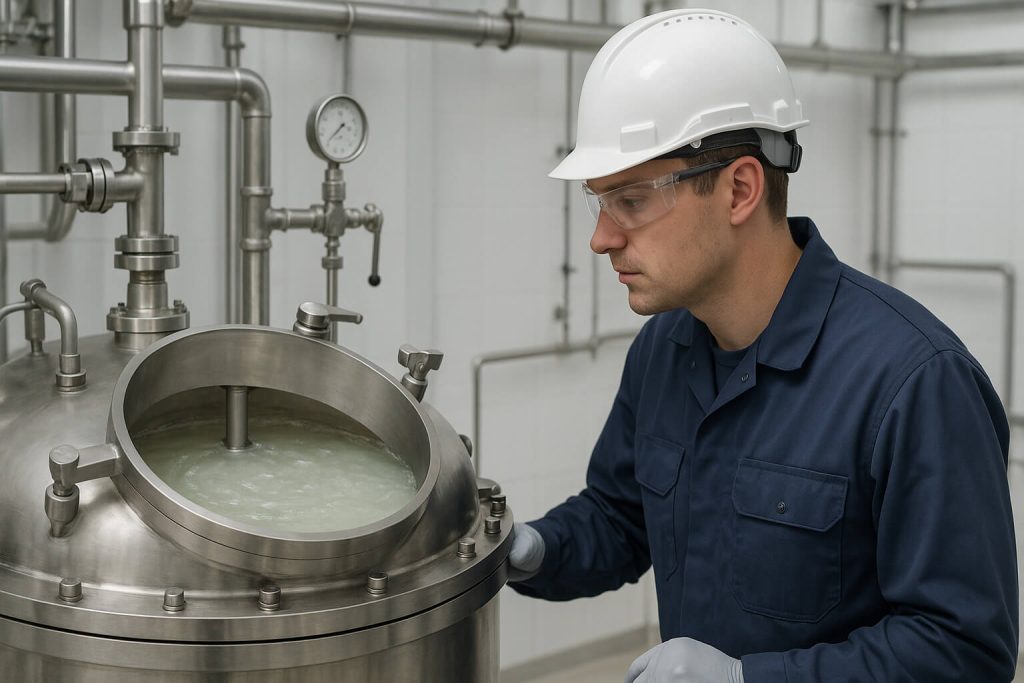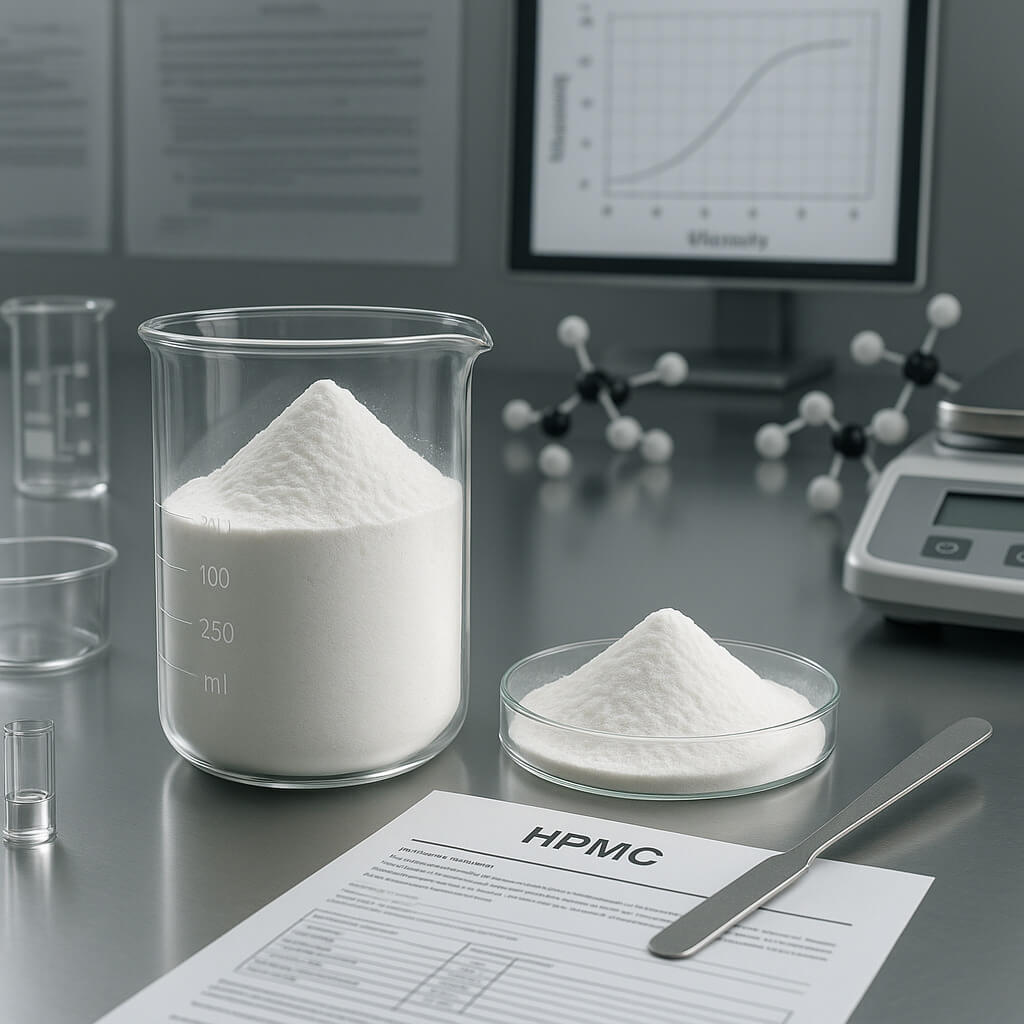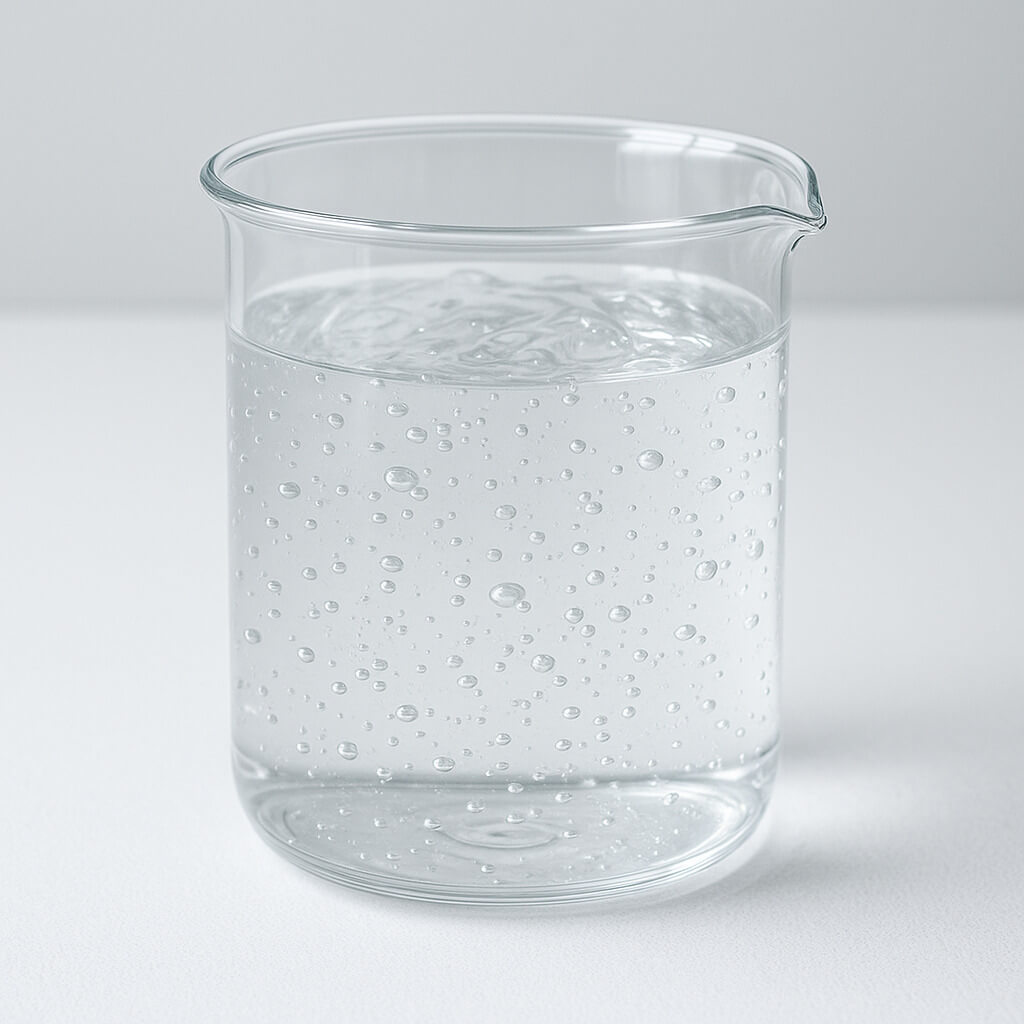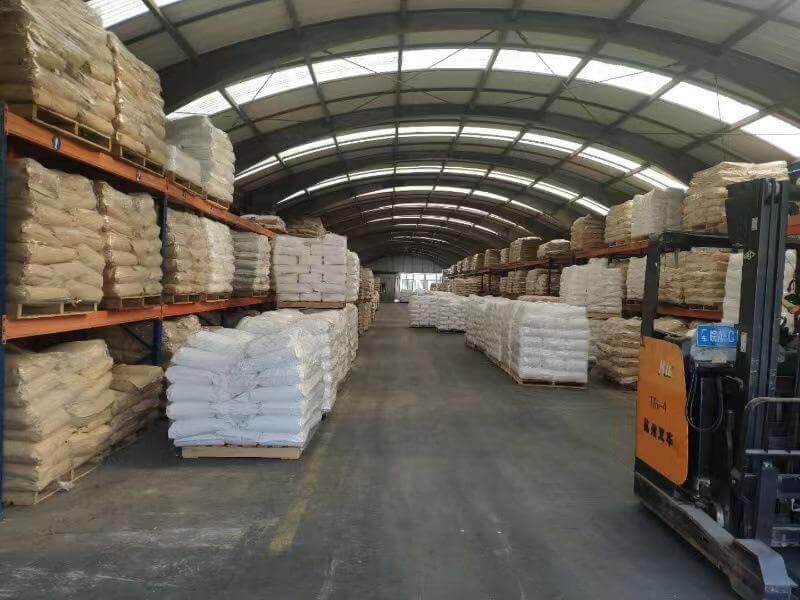HPMC gelation temperature creates problems for many factory processes. When HPMC gets too hot, it can suddenly form gels. This stops production lines, changes how products work, and causes quality issues. These problems waste materials and cost companies money. The good news? When you know the exact heat levels that trigger HPMC gelation, you can keep your processes running smoothly. This article shows you the key temperature ranges where HPMC forms gels, what affects this process, and how to control gelation in your products.

1. What Is HPMC and How Does Its Gelation Work?
HPMC stands for hydroxypropyl methylcellulose. It comes from plant cellulose that gets changed in labs. Many industries use it because it works well in different products.
HPMC has a cellulose backbone with added hydroxypropyl and methyl groups. These changes make it dissolve in water and react to temperature changes.
But here’s what makes it special: HPMC acts opposite to most polymers. It dissolves in cold water but forms gels in hot water. As heat rises, the material changes state.
The gel forms because of how the methoxy groups interact. In cold water, these groups stay apart with water molecules around them. When heated, this water shell breaks down.
Without the water shell, the parts of HPMC that hate water start to stick together. They form a network that traps water, creating a gel.
| HPMC Property | What It Is | Why It Matters |
|---|---|---|
| Chemical Makeup | Cellulose with methyl and hydroxypropyl groups | Affects how it mixes with other ingredients |
| Water Behavior | Dissolves in cold water, gels in hot water | Lets you control it with temperature |
| Thickness Range | 3 to 100,000 mPa·s (varies by type) | Changes how it flows and how you apply it |
| Chemical Groups | 19-30% methoxyl, 4-12% hydroxypropyl | Affects gel temperature and strength |
Different types of HPMC gel in different ways. This depends on their weight and chemical structure. Heavier HPMC makes stronger gels but may need different heat levels to work.
The methoxyl content greatly affects gel temperature. HPMC with more methoxyl groups gels at lower temperatures than types with less methoxyl.
2. What Is the Specific Temperature Range for HPMC Gelation?
Most HPMC types gel between 65°C and 90°C (149°F to 194°F). At these temperatures, the material changes from liquid to gel.
The exact temperature varies by HPMC type. Some special grades gel as low as 58°C or as high as 95°C for specific uses.
You should know this: Gelation doesn’t happen all at once. It starts at one temperature and finishes at a higher one. This creates a range where changes occur.
The weight of HPMC molecules affects gel temperature. Heavier types often gel at lower temperatures than lighter ones with similar chemical makeup.
| HPMC Type | Gel Temperature Range | Main Uses |
|---|---|---|
| Low Methoxyl HPMC | 75-90°C | Building products, glues |
| Medium Methoxyl HPMC | 65-80°C | Drugs, food items |
| High Methoxyl HPMC | 58-70°C | Personal care, timed-release products |
| Special Types | 58-95°C | Custom factory needs |
How much HPMC you use affects when it gels. Stronger mixtures gel at lower temperatures than weaker ones of the same type.
For example, a 2% mix of medium-weight HPMC might gel at 75°C. A 5% mix of the same HPMC could start gelling at 70°C. This lets you fine-tune when gelation happens by changing how much HPMC you use.
3. How Do Manufacturing Processes Affect HPMC Gelation Temperature?
How HPMC gets made greatly changes its gel temperature. The making process sets how many methoxyl and hydroxypropyl groups attach to the cellulose chain and where they sit.
The reaction settings during HPMC making—heat, pressure, and catalysts—affect how the final product reacts to heat. Makers can adjust these factors to create HPMC with specific gel temperatures.
Here’s the key point: Even small changes in production can cause batch-to-batch differences in gel temperature. This makes strict quality testing vital for steady results.
The degree of substitution (DS) and molar substitution (MS) greatly affect gel temperature. DS means how many hydroxyl groups get replaced per glucose unit. MS shows how many moles of new groups get added per glucose unit.
| Substitution Factor | Normal Range | Effect on Gel Temperature |
|---|---|---|
| Methoxyl Content (%) | 19-30% | More methoxyl lowers gel temperature |
| Hydroxypropyl Content (%) | 4-12% | More hydroxypropyl raises gel temperature |
| Degree of Substitution (DS) | 1.2-2.0 | Higher DS often lowers gel temperature |
| Molar Substitution (MS) | 0.1-0.7 | Higher MS often raises gel temperature |
Making conditions can create HPMC with uneven substitution patterns. This sometimes causes wider gel temperature ranges instead of sharp change points.
Some makers use this trait on purpose to create HPMC types with gradual gelling profiles for uses where a sudden change would cause problems.
Quality checks for steady gel temperature include testing each batch made. Makers often use cloud point tests, flow tests, and heat flow tests to check thermal traits.
4. What Applications Benefit from HPMC’s Thermal Gelation Properties?
Drug makers widely use HPMC’s thermal gelling for controlled drug release systems. In pill forms, HPMC can create heat-responsive matrices that control how fast drugs release.
These systems stay liquid at room temperature for easy making but gel at body temperature (37°C) to provide slow release. By picking specific HPMC types, makers can tailor release patterns to treatment needs.
What makes this valuable: The gel creates a barrier that slows drug release, making treatments last longer and reducing how often patients need doses.
In eye drops, HPMC solutions that stay liquid during storage but gel when touching the warmer eye surface improve drug staying power and uptake. This heat-triggered change extends contact time with eye tissues.
| Industry | Use | How HPMC Gelling Helps |
|---|---|---|
| Drugs | Slow-release tablets | Forms gel barrier controlling drug flow rate |
| Building | Cement products | Keeps water in during curing process |
| Food | Baked goods | Gives structure during baking, improves texture |
| Personal Care | Hair styling products | Creates heat-activated hold |
| Ceramics | Extrusion mixes | Keeps shape during drying and firing |
The building industry uses HPMC’s thermal traits in cement products like tile glues, renders, and self-leveling mixes. HPMC helps keep water in during the key hydration phase of cement curing.
As outdoor temperatures rise on building sites, HPMC gelling helps stop water from drying too soon. This water keeping improves cement hydration, making stronger final products with fewer cracks.
Food makers use HPMC’s thermal gelling to create products with unique texture traits. In baked goods, HPMC stays dissolved during cold mixing but forms a gel structure during baking.
This gelling helps trap air bubbles in gluten-free baked goods, giving structure and volume that would be missing without gluten proteins.
5. How Can You Test and Measure HPMC Gelation Temperature?
Several standard methods exist for finding HPMC gel temperature in labs. These techniques give reliable data for quality checks and product development.
The cloud point method offers one of the simplest ways. This test involves slowly heating an HPMC solution while watching when it turns cloudy, showing the start of molecular grouping that comes before gelling.
This matters because: Exact gel temperature testing ensures steady product performance and helps fix process issues when they happen.
Flow testing gives more detailed info about the gelling process. Using a flow tester with heat control, techs can measure how thickness and elasticity change with temperature.
| Testing Method | Tools Needed | What It Measures | How Precise |
|---|---|---|---|
| Cloud Point | Water bath, thermometer, light | Temperature of first cloudiness | ±2°C |
| Flow Testing | Flow meter with heat control | Thickness changes, gel point | ±0.5°C |
| Heat Flow Testing | DSC tool | Heat changes, energy shifts | ±0.2°C |
| Tube Flip | Water bath, test tubes, thermometer | Complete gelling (self-supporting) | ±1°C |
| Falling Ball | Special tool, thermometer | Gel strength growth | ±1°C |
The tube flip test offers a practical way for quick checks. In this method, an HPMC solution in a sealed tube gets heated in steps. After each heat step, the tube gets flipped to see if the solution flows.
The temperature where the solution no longer flows when flipped shows complete gelling. This simple test needs minimal tools but still gives useful data for many uses.
6. What Factors Can Modify HPMC Gelation Temperature?
The pH level of a solution greatly affects HPMC gelling. Generally, HPMC shows best stability and steady gelling in neutral pH ranges (6-8).
In very acidic settings (pH < 3), the bonds in HPMC can break down, possibly changing the polymer structure and raising gel temperature. Very basic conditions may affect the hydrogen bonding patterns that drive gelling.
What you’ll find surprising: Even small pH shifts of 1-2 units can change gel temperature by 3-5°C in some HPMC types. This sensitivity makes pH control critical in mixes where exact gel temperature matters.
Additives and salts in the solution can greatly change HPMC gelling. Salts like sodium chloride, potassium chloride, and calcium chloride often lower the gel temperature through a “salting-out” effect.
| Factor | Effect on Gel Temperature | How Much Change |
|---|---|---|
| Acidic pH (< 4) | Raises gel temperature | +3 to +8°C |
| Basic pH (> 9) | Varies by HPMC type | -2 to +5°C |
| Salt addition (1%) | Lowers gel temperature | -3 to -15°C |
| Sugars (5%) | Raises gel temperature | +2 to +7°C |
| Alcohols (5%) | Lowers gel temperature | -5 to -20°C |
The amount and type of salt matter greatly. For example, divalent ions like calcium (Ca²⁺) often have a stronger effect than monovalent ions like sodium (Na⁺) at the same amount.
Sugar and polyol additives generally raise HPMC gel temperature. These compounds compete with HPMC for water molecules, blocking the water-hating groups from joining together. Adding 5% sugar to an HPMC solution can raise gel temperature by 3-7°C.
Mixing forces during processing, especially high shear rates, can affect gelling. Strong shear forces may briefly break up the forming gel network, making it seem like the gel temperature is higher during processing.
7. How Do You Select the Right HPMC Grade Based on Gelation Temperature?
Picking the right HPMC type means matching the gel temperature to your specific needs. Start by finding the temperature range your product will face during making, storage, and use.
For processes where gelling must be avoided, choose an HPMC type with a gel temperature at least 10-15°C above your highest process temperature. This safety margin helps prevent surprise gelling due to heat changes or hot spots in equipment.
The bottom line: Choosing the wrong HPMC type can lead to process failures, uneven product quality, and wasted materials. Taking time to select correctly saves money and problems.
For uses that need gelling at a specific temperature, you need an HPMC type that gels exactly within the target range. For example, drug delivery systems made to gel at body temperature need types that gel at 35-38°C.
| Application Need | How to Pick HPMC | Example Type Traits |
|---|---|---|
| Avoid gelling during processing | Choose type with gel temp 10-15°C above max process temp | High hydroxypropyl content, lower methoxyl content |
| Exact gelling at target temp | Select type with narrow gel range centered on target | Controlled substitution pattern, medium weight |
| Gradual thickening over temp range | Use types with broad gel profile | Mixed substitution, specific weight range |
| Cost-sensitive uses | Balance performance needs with cheaper types | Standard substitution patterns, widely available types |
Cost matters in type selection. Special HPMC types with precisely controlled gel temperatures often cost more than standard types. The price increase ranges from 15% to over 100% depending on how specific the thermal traits must be.
Supplier specs give critical info for HPMC selection. Review tech data sheets carefully, looking at gel temperature range, test method used, and mix strength at which gel temperature was tested.
Common mistakes in HPMC selection include ignoring how other mix components affect gel temperature and not accounting for process conditions. Always check thermal behavior at the actual use strength.
Conclusion
Knowing the exact temperature where HPMC gels gives you precise control over your making processes and product performance. Most HPMC types gel between 65-90°C, with changes based on chemical structure, mix strength, and other factors. You can pick the right type for your needs using this knowledge. Tests like flow testing and cloud point checks help verify gelling behavior. Paying attention to pH, additives, and process conditions lets you fine-tune thermal response. Morton offers special HPMC types with carefully controlled gel temperatures to meet your exact needs, plus tech support to improve your mixes. Contact our tech team today to discuss how our HPMC solutions can enhance your heat-sensitive uses and process efficiency.
FAQ Section
Q1: Can HPMC gelation be reversed after cooling?
Yes, HPMC gelling can usually be reversed. When a gelled HPMC system cools below its gel temperature, it slowly returns to a liquid state. This happens because the forces driving gel formation weaken at lower temperatures, letting water molecules re-form their shells around the methoxy groups. How fast it reverses depends on the HPMC type, strength, and cooling rate. Complete reversal may take hours for strong mixes or those with additives that stabilize the gel. This reversibility makes HPMC useful in uses needing temporary gelling followed by flow traits.
Q2: How does HPMC gelation temperature compare to other cellulose derivatives?
HPMC generally gels at higher temperatures (65-90°C) compared to methylcellulose (MC), which usually gels at 50-60°C due to its higher methoxyl content and lack of hydroxypropyl groups. Carboxymethylcellulose (CMC) and hydroxyethylcellulose (HEC) don’t show the same thermal gelling behavior as HPMC and MC; instead, they stay dissolved at high temperatures. Ethylcellulose (EC) doesn’t dissolve in water but forms structures in organic solvents with different temperature traits.
Q3: Does the gelation temperature of HPMC change over its shelf life?
The gel temperature of properly stored HPMC powder stays stable for 2-3 years under good storage conditions (cool, dry place in sealed containers). However, exposure to high humidity, extreme temperatures, or UV light can slowly change the polymer structure, possibly affecting gelling traits. Liquid mixes containing HPMC may show more noticeable changes in gel temperature over time due to possible breakdown, microbe growth, or reactions with other ingredients.
Q4: Can you adjust HPMC gelation temperature without changing grades?
Yes, you can change HPMC gel temperature by adjusting mix components rather than changing HPMC types. Adding salts (especially those with divalent ions like calcium) typically lowers gel temperature by 3-15°C depending on amount. Adding sugars or polyols raises gel temperature by blocking the water-hating interactions. pH adjustment offers another control method, with more acidic conditions generally raising gel temperature. Mixing different HPMC types provides another way to fine-tune thermal response.
Q5: What safety considerations exist when working with HPMC at its gelation temperature?
When working with HPMC near its gel temperature, several safety issues apply. First, processing equipment handling HPMC solutions must include temperature monitoring and control systems to prevent surprise gelling that could block pipes, filters, or nozzles. Pressure relief valves should be installed on closed systems to handle potential pressure buildup if gelling occurs. For personal safety, hot HPMC solutions pose burn risks, requiring proper protective gear. While HPMC itself has excellent safety records with FDA approval for food and drug use, gelling in processing equipment can create cleaning challenges needing special procedures.




